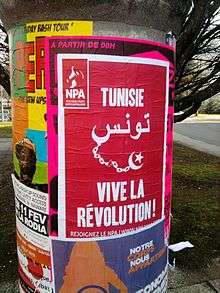Far-left politics
| Part of the Politics series | ||||||
| Party politics | ||||||
|---|---|---|---|---|---|---|
| Political spectrum | ||||||
|
||||||
| Party platform | ||||||
|
|
||||||
| Party system | ||||||
|
|
||||||
| Coalition | ||||||
|
|
||||||
| Lists | ||||||
| Politics portal | ||||||
Far-left politics are political views located further on the left of the left-right spectrum than the standard political left.
The term has been used to describe ideologies such as communism, anarcho-communism, left-communism, anarcho-syndicalism, Marxism–Leninism, Trotskyism, and Maoism.[1][2]
Europe

Luke March of the School of Social and Political Science at the University of Edinburgh defines the far-left in Europe as those who position themselves to the left of social democracy, which they see as insufficiently left-wing. The two main sub-types are called the radical left, who desire fundamental changes to the capitalist system yet remain accepting of liberal democracy, and the extreme left, who are more hostile to liberal democracy and denounce any compromise with capitalism. March specifies four major subgroups within contemporary European far-left politics: communists, democratic socialists, populist socialists and social populists.[3]
Vít Hloušek and Lubomír Kopeček add secondary characteristics to those identified by March and Mudde, such as anti-Americanism, anti-globalization, opposition to NATO and rejection of European integration.[4]
In France, the term extrême-gauche ("far-left") is a generally accepted term for political groups that position themselves to the left of the Socialist Party, such as Trotskyists, Maoists, anarcho-communists and New Leftists. Some, such as political scientist Serge Cosseron, limit the scope to the left of the French Communist Party,[5] but there is no real consensus.
Far-left terrorism

There were many far-left militant organisations formed from existing political parties in the 1960s and 1970s,[6] such as the Red Brigades and the Red Army Faction.[7] These groups generally aimed to overthrow capitalism and the wealthy ruling classes.
See also
- Category:Far-left political parties
- Hard left
- List of anti-capitalist and communist parties with national parliamentary representation
- Moonbat
- Ultra-leftism
References
- ↑ Left Communism in Australia, by J.A. Dawson Thesis 11]
- ↑ Left Communism and Trotskyism, by Loren Goldner et al.
- ↑ March, Luke (2008). Contemporary Far Left Parties in Europe: From Marxism to the Mainstream? (PDF). Berlin: Friedrich-Ebert-Stiftung. p. 3. ISBN 9783868720006. Retrieved 3 June 2017.
- ↑ Hloušek, Vít; Kopeček, Lubomír (2010). Origin, Ideology and Transformation of Political Parties: East-Central and Western Europe Compared. Farnham: Ashgate. p. 46. ISBN 9780754678403.
- ↑ Cosseron, Serge (2007). Dictionnaire de l'extrême gauche. Paris: Larousse. p. 20. ISBN 2035826209.
- ↑ Weinberg, Leonard; Pedahzur, Ami; Perliger, Arie (2009). Political Parties and Terrorist Groups (2nd ed.). London: Routledge. p. 53. ISBN 9781135973377.
- ↑ Chaliand, Gérard (2010). The History of Terrorism: From Antiquity to Al Qaeda. Berkeley, California: University of California Press. ISBN 9780520247093.
External links
